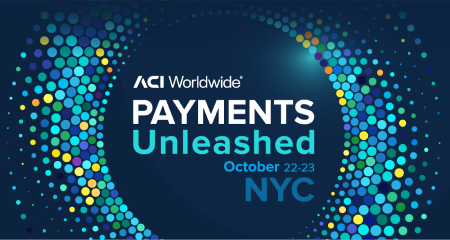- Solutions
- Banking
-
- ACI ConneticUnified cloud payments platform
- AcquiringDigital acceptance, merchant management
- IssuingDigital payments and accounts issuing
- Fraud managementReal-time enterprise fraud management
- RTGS / Wires and cross-borderMulti-bank, multi-currency processing
- Real-time, instant paymentsComplete real-time payments processing
- ATMsSelf-service, omnichannel digital experience
- Central infrastructureInnovative real-time payment infrastructure
- NEW Payment Hubs: Why Banks Must Move Forward With Urgency
-
- Merchant payments
- ACI Payments Orchestration PlatformEnable customer journeys across commerce channels, accept payments, prevent fraud and optimize your payments journey
- In-storeDynamic, modern in-store payments
- eCommerceOnline and mobile payments
- Alternative payment methodsGive more ways to pay
- Value-added servicesEngagement, optimization and reporting
- Fraud managementEnd-to-end fraud orchestration
- Risk, security, and complianceAchieve and maintain compliance
- NEW Datos names ACI Worldwide best-in-class in payments orchestration
- Industries we serve
- Billing and bill payments
- ACI SpeedpayDrive customer satisfaction with the widest range of bill pay options in the industry.
- Bill payment APIs and SDKsOutsource bill payment processing
- Fraud managementAI-based fraud orchestration technology
- Alternative payment methodsGive more ways to pay
- Loan servicingPreferred loan payment options
- Treasury managementStreamline and integrate your back office
- Automated debt collectionImprove your collections process
- Digital walletsManage digital cards and payments
- PCI compliance and securityAchieve and maintain PCI compliance
- Industries We Serve
- Fraud management and payments intelligence
- Fraud managementFraud solutions to minimize risk and prevent fraud
- Fraud management for bankingEnterprise-wide fraud prevention
- Anti-money launderingStay ahead of money-laundering schemes
- Robotic process automationAutomate payment processing operations
- Fraud management in the cloudProtecting your business in the cloud
- Fraud management for merchantsProtect payments from end to end
- ChargebacksPrevent chargebacks before they happen
- SCA complianceAchieve and maintain SCA compliance
- Digital identity solutionsConfirm identities with behavioral analytics
- NEW Scamscope fraud report: APP scam trends from around the globe
CompanyCustomersPartners
Home
On This Page
We live and work in an increasingly real-time world. Businesses and consumers take for granted access to ever better, ever more cost-effective, and ever safer digital services and experiences.
To sustain this cycle of continuous improvements, faster and more flexible payments are as key as any technological development. Hence the acceleration in the development of next-generation payment schemes around the world.
At the heart of these schemes’ functionality is real-time payments, which research from ACI Worldwide and GlobalData has forecasted to account for 27.8% of all electronic payments globally by 2027. But, as the same research has shown, what actually drives adoption is the range and utility of use cases built on top of that real-time functionality.
By creating the conditions in which financial institutions, fintechs and all-new market entrants can embed and scale next-generation payments across digital customer experiences, governments and regulators can accelerate the realization of the economic benefits of faster and more efficient payments.
For Aotearoa New Zealand, which is just starting out on its next-generation payments journey, those economic benefits could be significant. An independent study by the Centre for Economic and Business Research (Cebr), jointly commissioned by ACI Worldwide and Payments NZ, predicted cost savings for businesses and consumers facilitated by real-time payments of $100 million by 2027 if the country had a real-time payments system by 2025, in a fast-growth scenario. At the macroeconomic level, the fast-growth scenario also projects additional economic growth of $271 million, or 0.1%, by 2027.
There has never been a better time to develop a next-generation payments scheme. There are now more than 60 schemes live around the world, providing new entrants with a wealth of experience to draw from when it comes to driving adoption and unlocking economic growth.
On that basis, here are five key considerations when launching a next-generation payments scheme.
#1. Leverage a modular and flexible architecture to support a roadmap for growth
Payment habits and use cases have emerged in recent years that couldn’t have been imagined at the time that most of today’s payment schemes were developed. Not least the advent of mobile wallets and payments, online shopping and even crypto.
This illustrates the importance of building next-generation payment schemes on a modular, flexible architecture — one that leverages microservices and APIs in particular, making it cost-effective to manage and easy to change to enable new use cases. To become the foundational layer of a digital economy, next-generation payment schemes must be adaptable enough to continually find new ways to reduce friction in payments. Today, that means support for a whole ecosystem of payments functionality, from A2A and Request to Pay to mobile wallets and POS QR-code acceptance. Tomorrow, it will likely mean central bank digital currencies and cross-border connectivity. And beyond that…
#2. Standardize connectivity to drive innovation and promote openness
Standardized and simplified connectivity is vital for participants to be able to achieve a fast time to market on new solutions built on top of the scheme’s functionality. API-led integrations lower the technical burden of scheme compliance, enabling innovators in the wider tech community to access and develop new overlay services on top of their engines. APIs help by removing the need for costly and time-consuming custom integrations.
#3. Embrace change with ISO 20022
As the basis of every modern payments system, the ISO 20022 messaging standard is helping to drive significant change. Compared to legacy messaging standards, it enables the transmission of more structured, richer transaction data for better consistency and efficiency when processing payments.
ISO 20022 presents a genuine opportunity for financial institutions to reset much of the legacy entanglement, offering a methodology for unified communication between inter-bank or cross-border systems that speak the same language and can provide the data and information far more relevant to today’s needs. It allows financial services institutions to create new products, innovate and compete at new levels while bringing down costs and enhancing connectivity.
ISO 20022 will also enable more rapid cross-border connectivity, just as it does in the major ASEAN and global markets.
To learn more about how ISO 20022 will be the catalyst for a financial and economic revolution in ASEAN and Asia/Pacific – download this IDC InfoBrief
#4. Adopt fraud prevention from day one with us
New payment types and channels are always a target for fraud, which in the worst case risks undermining confidence and therefore adoption.
As such, any discussion around real-time payments must factor in fraud protection and mitigation. On the technology level, that means prioritizing enterprise-level, machine learning-driven fraud prevention and security systems from day one. The regulatory environment also needs to adapt to next-generation payments in order to offer similar protections and clarity around liability that cards and other payment methods enjoy.
#5. Decide on the role of central mandates
The approach of regulators differs around the world. Some are hands-on and set aggressive timelines with real consequences for non-compliance. Others take a gradual, consensus-driven, collaborative approach. The difference in terms of how far and how fast new use cases have taken hold is the work done in the previous years and decades by governments, regulators and central banks to set up national next-generation payment schemes. There needs to be a robust and fit-for-purpose regulatory framework to support the adoption of standards and processes that deliver real-time capabilities and the transformative use cases they enable.
When the perspective changes from “how do we add another rail?” to “how do we modernize payments to help build the digital economy?”, that’s when the new services get built, innovation accelerates and adoption takes off.
For more insights into key developments and trends in next-generation payments, read ACI’s Prime Time for Real-Time 2023 or Real-Time Payments and the Future in Aotearoa New Zealand .




